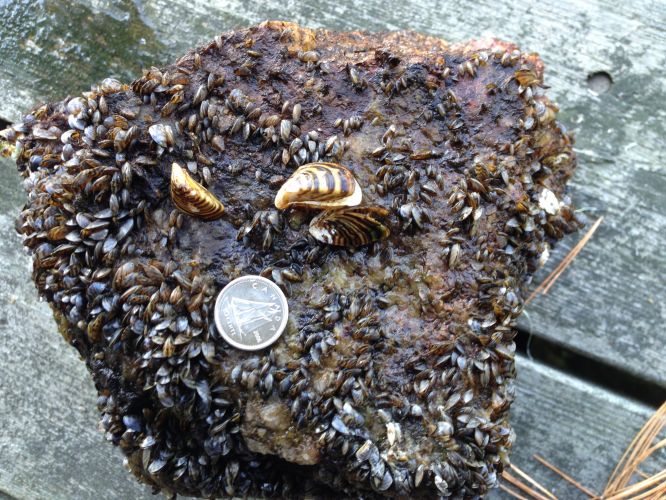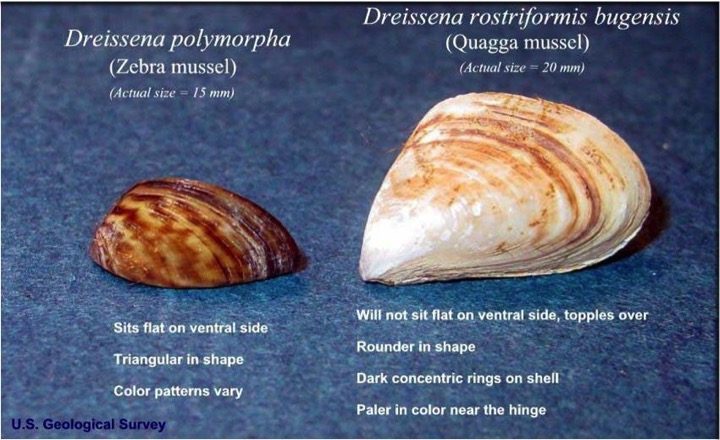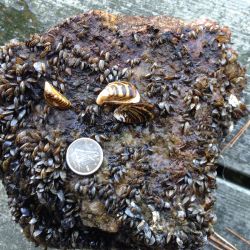
Priority: Prevent
General: Zebra & quagga mussels are small freshwater mussels that can be found in lakes, rivers, canals and ponds.
Size: Up to 2cm in length. Zebra mussels are generally smaller, 1.5cm.
Colour: Zebra mussels are usually striped with dark bands but can be black or have no colour. Quagga mussel usually have dark rings on the shell that are paler near the shell hinge.
Other Key Features: Both mussels have byssal threads that are used to attach to hard surfaces. Zebra mussel shells have a distinctive triangle shape and a flat edge where the byssal threads come out of. Quagga mussel shells are rounder and have a small groove near the hinge where the byssal threads appear. Zebra mussels have stronger byssal threads allowing them to attach to hard surfaces. Quagga mussels can also attach to softer surfaces such as sandy lake bottoms.

Native freshwater mussels: Example: Rocky Mountain Ridge Mussel (Gonidea angulata)
Invasive Asian Clam (Corbicula Fluminea). Refer to the BC Fact sheet (Don’t Move a Mussel) in the resources for a detailed comparison of mussels.
Differences: Native mussels found in freshwater environments do not have bysall threads so they do not adhere to surfaces. Invasive Asian Clam has a different shape shell: it is ovale and has a darker colour, yellow/green to brown. The shell is also larger, 6.5cm in diameter.
Where did it come from? Native to the Black, Caspian and Asove Seas.
Where does it live? There are no known populations of these invasive mussels in BC. REPORT ALL SUSPECTED infestations. They came into Canada through the ballast water in ships infesting the Great Lakes.
Reproduction: Zebra & Quagga mussels are related so have similar life cycles making them highly invasive. The male & female parts are in separate individuals. Females can lay up to 1 million eggs in a season.
When does it reproduce & mature? Optimal water temperatures for reproduction is 14-16o Celsius for Zebra mussels and lower (about 9) for Quagga mussels. Females lay eggs that hatch into larvae called veligers. In about 2-3 weeks, the free-floating veligers form a calcium shell and attach onto a hard surface. Zebra mussels reach sexual maturity after 1-2 years and can live for 3-9 years.
Spreads By: The veligers are in the water free floating and can move in water to different areas and water bodies within a watershed. Human related movement includes recreational boating, commercial shipping, bait buckets, bilges and equipment like barges and dredges. In North America, boats are the main way that these mussels move around. These types of invasive mussels can last out of water for up to 30 days.
Species Type: Freshwater Aquatic
- Zebra & Quagga mussels are filtration feeders and can permanently alter aquatic ecosystems by consuming phytoplankton. When phytoplankton is removed in large amounts, it can encourage the growth of toxic algae causing blooms. Water clarity can be altered.
- Invasive mussels rapidly adhere to infrastructure like water intakes, hydro-electrical facilities and agriculture irrigation. This has caused millions of dollars of removal treatment in the US.
- Mussels can impact the tourism industry. The sharp shells can wash up on beaches making it a hazard for people. Mussels can clog boat engines and intakes.
- REPORT all sightings.
- Clean off all plants, animals and mud from boat and equipment (includes fishing gear, waders and boots).
- Drain onto land everything that could hold water. Pull all of the plugs. Don’t forget buckets, wells, the bilge and ballast.
- Dry your boat, trailer & fishing gear before going to a new area and launching into a new waterbody.
- Dispose of bait in sealed containers.
- Stop at inspection stations with your boat: motor, canoe, kayak, paddleboard. BC has inspection stations set up in key locations near points of entry in to our province.
- Don’t Let it Loose: Don’t let any pet or aquarium plant loose because it may contain invasive species.
- Contact LRISS for more information.
Oregon Sea Grant. 2014. On the Lookout for Aquatic Invaders, Identification Guide for the West. Oregon State University. Multiple contributors and editors. 88 pages.
Photo Gallery

